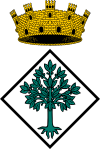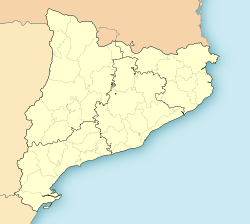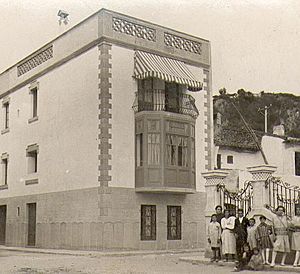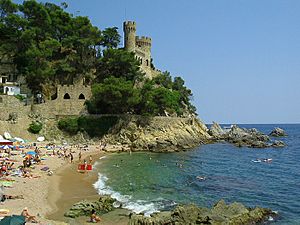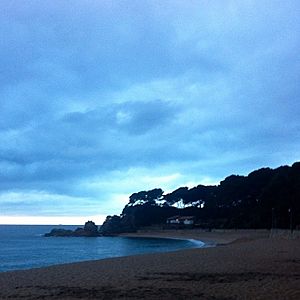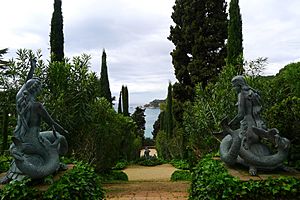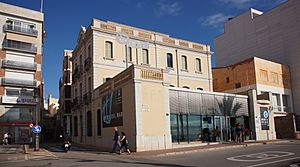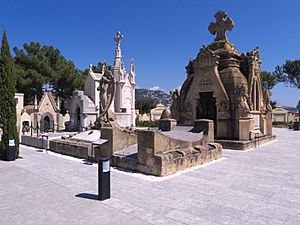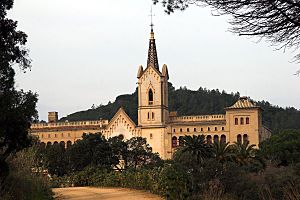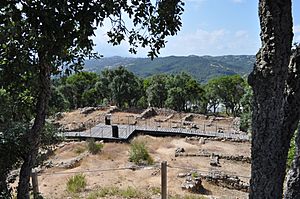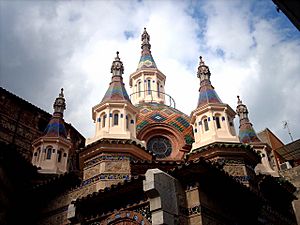Lloret de Mar facts for kids
Quick facts for kids
Lloret de Mar
|
|||
|---|---|---|---|
|
Municipality
|
|||
 |
|||
|
|||
| Nickname(s):
Lloret
|
|||
| Country | Spain | ||
| Autonomous Community | Catalonia | ||
| Province | Girona | ||
| Comarca | Selva | ||
| Area | |||
| • Total | 48.7 km2 (18.8 sq mi) | ||
| Elevation | 5 m (16 ft) | ||
| Population
(2018)
|
|||
| • Total | 37,350 | ||
| • Density | 766.9/km2 (1,986.4/sq mi) | ||
| Demonym(s) | Lloretenc, lloretenca | ||
| Time zone | UTC+1 (CET) | ||
| • Summer (DST) | UTC+2 (CEST) | ||
Lloret de Mar is a lively coastal town in Catalonia, Spain. It sits by the Mediterranean Sea, about 40 kilometres (25 miles) south of Girona and 75 kilometres (47 miles) northeast of Barcelona. In 2021, its population was 38,402, making it the second largest town in the Selva area of Catalonia.
Lloret de Mar is a popular spot for summer visitors. Its main beach is long and beautiful, known for its small, gravel-like stones. This beach, like others in the area, often receives the Blue Flag award for being clean and well-managed.
Contents
Geography and Climate
Where is Lloret de Mar?
The town of Lloret de Mar covers about 48.9 km2 (18.9 square miles) of land. It has 9 km (6 mi) of coastline and 27 km2 (10 sq mi) of forest. It shares borders with Vidreres and Maçanet de la Selva to the west, and the Mediterranean Sea to the east. To the north is Tossa de Mar, and to the south is Blanes.
What is the climate like?
Lloret de Mar has a mild climate, influenced by the sea. Summers are usually dry, and most rain falls in the autumn. The sea helps keep temperatures from getting too extreme.
| Climate data for Climate parameters, average maximum and minimum temperatures in Lloret de Mar for the period 1997 to 2001 | |||||||||||||
|---|---|---|---|---|---|---|---|---|---|---|---|---|---|
| Month | Jan | Feb | Mar | Apr | May | Jun | Jul | Aug | Sep | Oct | Nov | Dec | Year |
| Mean daily maximum °C (°F) | 14.8 (58.6) |
16.9 (62.4) |
20.1 (68.2) |
19.9 (67.8) |
24.1 (75.4) |
27.9 (82.2) |
30 (86) |
30.8 (87.4) |
27.5 (81.5) |
23.0 (73.4) |
17.4 (63.3) |
15.4 (59.7) |
22.1 (71.8) |
| Mean daily minimum °C (°F) | 4.5 (40.1) |
4.6 (40.3) |
6.6 (43.9) |
7.5 (45.5) |
11.9 (53.4) |
15.4 (59.7) |
17.0 (62.6) |
18.2 (64.8) |
15.4 (59.7) |
12.2 (54.0) |
6.8 (44.2) |
4.6 (40.3) |
10.2 (50.4) |
| Average precipitation mm (inches) | 56.2 (2.21) |
13.6 (0.54) |
16.9 (0.67) |
42.2 (1.66) |
34.2 (1.35) |
32.9 (1.30) |
28.4 (1.12) |
23.8 (0.94) |
62.2 (2.45) |
33.2 (1.31) |
68.5 (2.70) |
55.2 (2.17) |
467.3 (18.40) |
| Source: Agenda21 | |||||||||||||
History of Lloret de Mar
Early Settlements and Medieval Times
People have lived in Lloret de Mar for a very long time. You can find ancient remains from Iberian and Roman times. The town's name, Loredo, first appeared in documents in 966. It comes from a Latin word meaning "bay laurel."
Like many towns by the Mediterranean Sea, Lloret was often attacked by Saracen pirates during the Middle Ages. To stay safe, the town's center was built about 0.6 miles inland until the 15th century. This was near the Chapel of Les Alegries. Later, the Church of Sant Romà was built.
From Trading to Tourism
In the 18th century, Lloret's port became very important for trade. Although the port is gone now, you can still see the grand Garriga Houses. These were built by Indianos, who were Spanish people who returned rich after making their fortunes in the Americas. These wealthy families built beautiful homes, changing the look of the town.
The first holidaymakers started visiting Lloret in the early 1900s. The first hotel, "Costa Brava," opened in 1920. However, the Spanish Civil War and the years after it slowed down this early tourism. Still, people from Barcelona soon started coming for vacations.
Places to Visit
Lloret de Mar has many interesting places to explore, from old churches to beautiful gardens.
- Church of Sant Romà: This Gothic church was finished in 1522. It was built to protect people from pirate attacks. Later, in the early 20th century, it was restored with money from the wealthy Americanos. Now, it shows a mix of styles, including Byzantine, Moorish, Renaissance, and Modernist influences.
- Castle of Sant Joan: This medieval castle from the 11th century was a lookout point to defend Lloret from sea attacks. Only its tower remains today, but it was restored in 1992 and offers amazing views.
- Monument to the Fisherman's Wife: This bronze statue is at the end of Lloret beach. It was put there in 1966 to celebrate Lloret de Mar's 1000th anniversary. It's a famous symbol of the town. Legend says if you touch its foot while looking at the sea, your wishes will come true!
- Santa Clotilde Gardens: These beautiful gardens were designed in an Italian Renaissance style. They are on top of a cliff, giving you stunning views of the sea.
- Modernist Cemetery: This cemetery is very special because of its unique art. Many wealthy Indianos built impressive tombs here. You can see works by famous architects like Bonaventura Conill i Montobbio, a student of Gaudí.
- Iberian Settlements: You can visit ancient Iberian settlements like Puig de Castellet and Montbarbat. These sites show how people lived here thousands of years ago.
- Maritime Museum - Can Garriga: This museum tells the story of Lloret de Mar's past as a seafaring and fishing town. It's located in an old Indiano house.
Nature and Beaches
Lloret de Mar is famous for its beautiful coastline. Many of its beaches have been awarded the Blue Flag for their quality.
Beaches and Coves
- Lloret Beach: This is the main beach in the town center. It's long, with coarse, white sand. It's divided into three sections, each with a name from local fishermen.
- Fenals Beach: Located between Sa Boadella cove and Lloret beach, this beach has coarse sand and is about 700 m (2,297 ft) long. It's in a semi-urban area and has a pine grove nearby.
- Cala Boadella: This lovely cove is surrounded by cliffs and thick pine trees. It's a coarse sand beach, about 250 m (820 ft) long. The Santa Clotilde Gardens are on the cliffs above it.
- Santa Cristina Beach: A fine sand beach about 450 m (1,476 ft) long. It's sheltered by rocks and has a path leading to the chapel of Sant Cristina.
- Treumal Beach: This beach is a continuation of Santa Cristina beach and is surrounded by a leafy pine wood.
- Canyelles Beach: This beach has coarse, white sand and a small marina. It's located outside the town center.
- Sa Caleta: Found next to Lloret beach, this area is below a castle.
- Cala Banys: A rocky cove perfect for fishing and snorkeling.
Gardens
The Santa Clotilde Gardens are a great example of Catalan landscape design from the early 20th century. They are on a clifftop with amazing sea views. The gardens feature many different plants but few flowers, creating a unique look.
Protected Marine Areas
Lloret de Mar has a special protected area in the sea called a biotope. This artificial reef was created in 1994 to help marine life grow and protect the underwater plants. It also supports local fishing.
Culture and Art
Maritime Museum
The Maritime Museum is in Casa Garriga, an old Indiano house. It tells the story of Lloret de Mar's history with the sea, focusing on fishing and the wealthy Indianos. You can learn about coastal trade and long voyages across the Atlantic Ocean.
Castle of Sant Joan
The Castle of Sant Joan sits on a hill between Lloret de Mar and Fenals beaches. It dates back to the 11th century and was used to watch for attacks from the sea. The castle was very important for the town's early history. In 1805, during a war, the British Navy bombed the tower, causing a lot of damage. The tower was restored in 1992 and is now open to visitors.
Modernist Cemetery
The modernist cemetery of Lloret de Mar is one of the most important cemeteries of its kind in Catalonia. It was built for the wealthy Indianos who returned from the Americas. The cemetery features stunning tombs and monuments in the modernist style. Architects like Bonaventura Conill i Montobbio, a student of Gaudí, designed many of the beautiful works here. The cemetery opened in 1901 and is a unique place to see funerary art from that time.
Modernist Buildings
Several architects, including Enric Monserdà, Bonaventura Conill, and Puig i Cadafalch, designed beautiful modernist buildings in Lloret. These include the Sanctuary of Sant Pere del Bosc and parts of the Church of Sant Romà.
Iberian Settlement at Puig de Castellet
Lloret de Mar has three ancient Iberian settlements: Montbarbat, Puig de Castellet, and Turó Rodó. These date back as far as the 4th century BC. The Iberians were the native people of the Iberian Peninsula. The Puig de Castellet settlement, from the 3rd century BC, was a small fortified village with about six homes. It was protected by a thick wall and towers, especially during the Punic Wars. This site is now part of the "Route of the Iberians."
Indiano Houses Route
The Indiano families had a big impact on Lloret de Mar. Many people from Lloret went to America in the 1800s to seek their fortune, especially in Havana and Matanzas, Cuba. When they returned, they were called Indianos or Americanos. They often gave money for charity projects, like hospitals and schools, and helped rebuild the local church.
- Casa Garriga (Maritime Museum): This house was built by Enric Garriga i Mataró, an Indiano who made his fortune in Cuba. It now houses the Maritime Museum.
- Passeig Verdaguer: This promenade was built on land reclaimed from the sea, thanks to the Indianos. Many of their grand homes were built here.
- Carrer de les Vídues i Donzelles: This street has a funny name, "Widows and Maidens." It refers to a legend about young women who became rich widows when their Indiano husbands died.
- Parish Church and Church of Sant Romà: The Indianos helped fund the modernist rebuilding of the church in 1914.
- House of Nicolau Font i Maig: This Indiano house, built in 1877, has a beautiful modernist wooden door with special designs.
Es Tint
Es Tint is a small building where Lloret's fishermen used to dye their nets until the 1960s. They used a liquid made from boiling pine bark and water. This helped make the nets stronger and blend in with the sea. When nylon nets became popular, this tradition faded. Today, only a few places like Es Tint still exist on the Costa Brava.
Outdoor Activities
Hiking Trails
Lloret de Mar is a great place for hiking, with parts of the famous GR92 Mediterranean footpath passing through.
- Stage 11: This path goes from Tossa de Mar to Lloret de Mar, covering about 14.5 km (9.0 mi).
- Stage 12: This section goes from Lloret de Mar to Blanes and Tordera, about 17.2 km (10.69 mi).
Coastal Footpaths
The Lloret de Mar - Fenals coastal footpath lets you walk along the beautiful coastline. It starts at Lloret's seafront and winds along rocky areas, passing by small coves and the Dona Marinera (Seafarer's Wife) statue. It also goes by the medieval Castle of Sant Joan before ending at Fenals beach.
Events and Festivals
Lloret de Mar hosts many exciting events throughout the year.
- Carnestoltes (Carnival King): In February, Lloret de Mar celebrates carnival with colorful parades.
- Rally Costa Brava: This is Spain's oldest rally event, and Lloret de Mar has been part of it since 1953. You can see classic cars and famous drivers.
- Mediterranean International Cup (MIC): Held in April, this is a big international youth football tournament. Young players from top clubs like Barcelona and Real Madrid compete here. Many famous footballers, like Lionel Messi and Neymar, played in the MIC when they were young.
- Lloret Formula Weekend: In May, this event is for Formula 1 fans. You can experience driving a Ferrari, try F1 simulators, and watch a parade of real race cars.
- Lloret Night Shopping: In May and September, shops stay open late with live music and fashion shows.
- Rice Gastronomy Days: In May, local restaurants create special dishes using rice and fresh seafood or mountain ingredients.
- Americanos Fair: In June, the town goes back in time to the Indiano period. The streets are filled with theater, crafts, and guided tours.
- Beaches Fun Walk: On the last Sunday in September, people enjoy an 11 km (7 mi) walk along the coastal path, offering great views.
- Cuina del Peix de l'Art Gastronomy Days: In October, this event celebrates Lloret's fishing history with special fish and seafood dishes.
- Rally Costa Brava Històric: Since 2003, Lloret has hosted this rally for vintage cars, bringing back the excitement of classic races.
- Medieval Fair: In November, during the festivities of Sant Romà, the town transforms into a medieval fair with stalls, music, magic, and games.
- Tirada a l’Art: In February and December, this traditional fishing technique is recreated on Lloret's main beach. Fishermen cast nets at dawn and pull them back to shore, catching fish.
Population and Economy
Population Growth
Lloret de Mar's population has grown a lot, especially since the year 2000. Many new residents have moved to the town.
| 1900 | 1930 | 1950 | 1970 | 1986 | 2009 |
|---|---|---|---|---|---|
| 3,242 | 3,012 | 3,159 | 7,064 | 14,567 | 39,363 |
Tourism in Lloret de Mar
Tourism is very important to Lloret de Mar's economy. In 1987, Lloret had almost half of all the hotel beds on the Costa Brava. It is one of the biggest "sun and sand" destinations in Spain.
Lloret de Mar has over 120 hotels with about 30,000 beds. Most visitors stay for about 5 days. The town has been working to become an "urban beach" destination, which means it offers not just sun and sand, but also history, culture, and many activities.
Lloret de Mar has special awards for tourism:
- Sports Tourism Destination: Since 2006, Lloret has been recognized for its great sports facilities and services for athletes and sports fans.
- Family Tourism Destination: In 2010, it received this award for being a good place for families to visit.
Shopping
Lloret de Mar has many shops, especially in the old town. Since 2010, shops can open every day of the year. There are also special shopping events like Lloret Night Shopping and the Medieval Fair. You can also visit the weekly street market every Tuesday.
Getting Around
Roads
You can reach Lloret de Mar by road from the north (Tossa de Mar), south (Blanes), or inland (Vidreres). The inland road connects to major highways. The coastal roads lead to Barcelona (80 km (50 mi) away) and the French border (100 km (62 mi) away).
Buses
Lloret de Mar has bus services to Barcelona, Girona, and other European cities. There's an international bus station and a local bus network that connects all parts of the town.
Taxis
There are four taxi stands in Lloret with over 40 taxis available 24/7.
Trains
Lloret de Mar doesn't have its own train station. The closest one is in Blanes. From Blanes, you can take a train to Barcelona or other towns. A shuttle bus connects Lloret's bus station to Blanes railway station.
Canyelles Marina
The only marina in Lloret de Mar is at Canyelles beach. It's suitable for medium-sized boats.
Boat Trips
During summer, you can take boat trips from Lloret de Mar to nearby towns like Blanes, Tossa de Mar, and Sant Feliu de Guíxols.
Airports
The closest airports are Barcelona airport (75 km (47 mi) away) and Girona airport (30 km (19 mi) away). Girona airport is popular with low-cost airlines, connecting Lloret to many European cities.
Notable People
- Marc Muniesa (1992), a professional footballer.
Sports
Lloret de Mar has a strong roller hockey team called CH Lloret. They play in the main league in Catalonia, the OK Liga.
Images for kids
See also
 In Spanish: Lloret de Mar para niños
In Spanish: Lloret de Mar para niños



